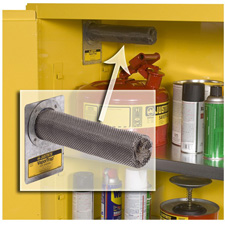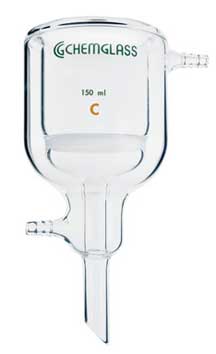



Find all of your laboratory and workplace safety supplies at Safety Emporium!
 Action Level |
 Glossary Index |
 Acute Toxicity |
| MSDS Topics |
Free Sites | FAQ's | Regulations | Glossary | Software | Suppliers |
| Books | Forum | Poll | Fun stuff | Quiz | Store | |
| Understand your MSDS with the MS-Demystifier | Search ALL our MSDS info | |||||
Activated charcoal or activated carbon is an amorphous form of carbon. This means that it has no regular solid state atomic structure, unlike the other forms (allotropes) of elemental carbon: diamond, graphite, fullerenes or nanotubes.
Activated charcoal differs from the familiar charcoal that is used in barbecue grills. Common charcoal contains other organic residues, is much less porous, and has a lower surface area.
Trade names for activated carbon include Norit® and Ultracarbon®.

Justrite's VaporTrap™ Filter for VOC Vapors uses activated carbon to reduce harmful VOC levels in your workplace.
Charcoal is obtained by burning wood, nutshells, coconut husks, animal bones, and/or other carbonaceous (carbon-containing) materials. Charcoal becomes activated by heating it with steam to approximately 1000 oC in the absence of oxygen (O2). This treatment removes residual non-carbon elements and produces a porous internal microstructure having an extremely high surface area. A single gram of such material can have 400 to 1,200 square meters of surface area, 98% of it internal!
The chemical nature of amorphous carbon, combined with a high surface area and porosity, makes it an ideal medium for the adsorption and absorption of organic chemicals. Adsorption means that the chemical has an interaction with the surface of the material; absorption is incorporation into a host structure through pores (interstices). To avoid confusion, we can refer to the incorporated material as "sorbed".
Activated carbon can remove organic materials from gas streams or solutions. The amount of material removed depends on the capacity of the activated carbon as well as the affinity of the material for the carbon. Typical uses are to remove odors and volatile organic compounds (VOC's).
Laboratory chemists often use activated carbon to remove colored impurities from crude organic reaction products. Typically, one dissolves the material in a solvent (if it is not already a liquid), adds activated carbon, and then filters the mixture to remove the carbon. This technique works well for colorless or lightly colored materials; in general, colored impurities tend to have molecular structures that make them bind preferentially to the charcoal.
Activated charcoals impregnated with other materials are also effective industrial and laboratory catalysts for chemical reactions. For example, vegetable oils may be hydrogenated by exposing them to a hydrogen atmosphere in the presence of a carbon-supported palladium catalyst.

Need to filter something? We have all kinds of filtration apparatus like this one from Safety Emporium.
Activated charcoal can appear in several ways on an SDS:
NEVER attempt to use regular charcoal briquettes (the kind you buy at a store for a barbecue grill) as a substitute for activated charcoal.
See also: antidote, catharsis, emetic, poison, respirator, smoke.
Additional definitions from Google and Onelook.
Entry last updated: Wednesday, February 16, 2022. This page is copyright 2000-2025 by ILPI. Unauthorized duplication or posting on other web sites is expressly prohibited. Send suggestions, comments, and new entry desires (include the URL if applicable) to us by email.
Disclaimer: The information contained herein is believed to be true and accurate, however ILPI makes no guarantees concerning the veracity of any statement. Use of any information on this page is at the reader's own risk. ILPI strongly encourages the reader to consult the appropriate local, state and federal agencies concerning the matters discussed herein.